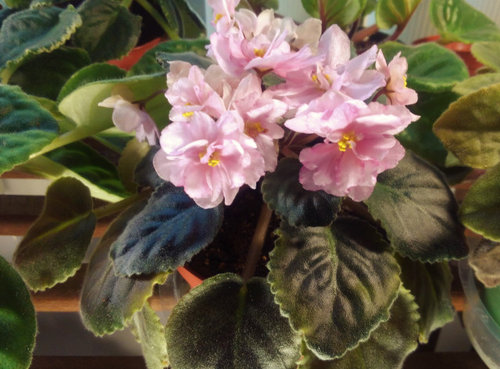

Maybe 5 deep soakings over the course of the summer. Then soak it well and don't water again until it totally dries out again. I would not water until it had been very hot and dry for several weeks. A bunch of water is just asking for rot IMHO.

In my opinion, if you have to cut the taproot, the yucca is going to be set back no matter what you do. Of course you'll want to have your holes dug before digging the elatas. Recurvifolia doesn't even need roots, it will regenerate new ones. I have not transplanted a yucca that has grown in place from seed container grown specimens transplant beautifully even many years later. For example, another 'taprooted' species, the pawpaw, is very different from most other North American deciduous tree species, in that it carries out virtually no root growth during the dormant period - once it goes dormant, every part of the plant is dormant so.when digging and transplanting pawpaw seedlings, the best time to do so is in spring, just as they're breaking dormancy, or in late summer, before they begin the descent into fall dormancy. Again, season of digging/transplanting may have a significant impact. Most survive quite nicely, in spite of it. I certainly try to preserve as much taproot as is possible, but occasionally, due to close spacing in the seedling beds and unexpected root orientations, these trees come out with less than 1 ft of intact taproot. I've dug and transplanted thousands of strongly-taprooted seedlings - pecans, walnuts, hickories, oaks - and sometimes these have been 3, 4, 5-yr old seedlings, frequently taller than myself. More and more commercial nurseries are root-pruning/undercutting their taprooted species during the first or second growing season, in order to promote development of a more lateralized root system, which translates into a higher transplant survival rate. I wasn't attacking Eric's post, just trying to debunk the myth I see put forward frequently that 'if you cut the taproot, the tree will die'. My point exactly, Sam it's virtually impossible to dig a seedling of any size without losing some root mass. The beds are typically 4 feet wide and 12 or more feet long, with 3 foot paths between the beds. The basic concept of French Intensive gardening is that raised beds are created which have humus added, and the whole bed is light and fluffy to a depth of two feet to promote fantastic root growth. The spaces between the rows are than rototilled to eliminate footprints prior to the initial watering. In regular garden rows, it is easy to roll a heavy 2 or 3 inch wide weighted wheel (mounted on an axle and handle) down the row directly over the freshly planted seeds, which will then promote deep root growth along that line. But the capillary action is absolutely necessary to bring water up to the roots of growing plants to promote good and deep root growth. And of course people are told never to step in a French Intensive bed and thus compress the soil. That is why gardening books tell you never to walk between rows in a regular garden, as that encourages weed growth. It is a proven fact that compressed earth has a better capillary action than undisturbed soil. One of the least understood aspects of gardening is that of capillary action of the garden soil. DO NOT use beach or river sand! Mason's sand, being crushed granite, has sharp edges and actually loosens the soil. Heavy clay soils can be improved considerably by adding a lot of sawdust and mason's sand. Obviously a heavy clay soil is very difficult to initially dig, whereas a sandy loam is much easier. Research continues to reveal that insoluble tiny particles like rock powder minerals, can be easily digested or absorbed via microbial activity, over time, into the anatomy of growing plants, thriving in the presence of rich organic compost, and other forms of powerful biostimulants like aerobic compost teas. In locations where seaweed is not readily available rock powders is one answer to the problem. There can be up to 70+ trace elements in seaweed. Seaweeds of course are the king of micronutrient fertilizers and soil amendments. Granite rocks are rich in potassium, etc. For example, limestone rocks are rich in calcium. As the microbes and macrobes like earthworms, digest the insoluble minerals, they break down into the various soluble micronutrients that all forms of plants need. All rock powders are great sources of minerals and micronutrients. a Treatise on Decomposed Granite: Decomposed granite is a rock powder and is an excellent amendment for clay soils. Your clay is wonderful, but you have to teach it to behave. Hey veggiefaery, If it is getting hard,there is not enough organic fluff (leaf and grass compost),if it is hard,I am assuming clay ? If clay,add Decomposed granite (lots) and Pumice again.


 0 kommentar(er)
0 kommentar(er)
